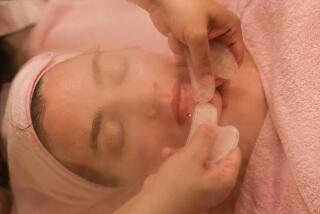Skin care in your 20s, 30s, 40s, 50s, 60s and beyond

Every few months a new beauty trend, treatment or potion is revealed — the latest skin-tightening laser, an age-defying ingredient or a longer-lasting filler. But should a fresh-faced 20-year-old be using retinol creams? And when is the right time to consider Botox? In the day of instant gratification, where do we draw the line between too soon and too late? We asked some experts for advice.
The 20s
In your 20s, wearing sunblock is the most important step you can take to prevent sun damage that leads to fine lines and wrinkles, says Dr. Simon Ourian, a dermatologist and founder of Epione Beverly Hills. Choose a physical sunblock instead of a chemical sunscreen. Products containing titanium or zinc dioxide are examples of the former, acting as a physical block to prevent the sun’s rays from reaching the skin. These kinds of products usually leave a whitish residue on your face. Chemical sunscreens, which tend to be clear on the skin, work with your top layer of skin to absorb UV rays before they cause damage but don’t give as much protection. “If you want to be serious, wear a hat,” Ourian adds.
Beverly Hills plastic surgeon Gabriel Chiu echoes the sentiment: “The 20s is about prevention. It takes 15 to 20 years to see the damage of environmental exposure on your skin.”
This is also the time to develop a skin-care regimen of proper cleansing and moisturizing. Ourian suggests sticking to natural products: “Anything you can’t pronounce, you don’t want to put on your skin.” Also, find a dermatologist or clinic you trust. Regular maintenance can help identify skin problems early and correct them before they require more aggressive treatments, Chiu says.
The 30s
Toward the end of your 20s and beginning of your 30s, the body’s ability to renew damaged skin cells quickly begins to decrease. Many women start seeing dynamic lines (caused by facial expressions) around the eyes and between the brows. The 30s may be the time to consider Botox to prevent these lines from growing deeper and more numerous, says Ourian. Botox relaxes the muscles used to form these expressive lines.
Skin in your 30s also can begin to look dull, and exfoliation is an easy at-home solution to brighten up complexions. Chiu recommends using an exfoliating product such as SkinCeuticals Micro-exfoliating Scrub ($28; https://www.skin
ceuticals.com), while Ourian suggests scrubbing with a Clarisonic Skin Cleansing brush ($149; https://www.clarisonic.com) every evening. Physical and chemical exfoliants smooth the skin and stimulate cell renewal, Chiu says.
Lastly, consider swapping your natural lotions for something that packs a little more power. Look for ingredients such as kojic acid, retinols and vitamin C.
The 40s
As gravity takes its toll, the cheeks start to fall, smile lines grow deeper and sun damage appears as skin discoloration or miasma. “Pores are larger, and skin is looser and less supple,” Ourian says. It’s time to consider dermal fillers, such as Restylane, Radiesse and Juvederm. Fillers can help diminish fine lines by plumping up the area and making skin appear smoother.
Another option: Laser resurfacing with Fraxel can diminish lines, reduce the appearance of sun damage and stimulate collagen. “You want to look like you just came back from a vacation,” Ourian says.
The 50s
In your 50s, hormonal changes can cause loss of elasticity and increase the dullness of the skin. Some women see the neck and jowls starting to sag, hyperpigmentation, deep furrows and marionette lines.
Take advantage of an array of options, from volumetric fillers that can lift cheekbones to stronger lasers that melt fat and tighten skin. “Fat transfer restores the volume lost from the process of aging,” Chiu says, “getting rid of the hollow under the eyes, adding volume to cheeks, reducing the look of nasal labial folds and marionette lines. Fat can be taken from any area with good fat deposits, such as the stomach, thighs or even the inside of the knees.”
The 60s and beyond
If you haven’t take care of your skin regularly on your way to your 60s, you may have to consider more aggressive measures. Plastic surgery options include blepharoplasty (which addresses the tired, excess skin of the eyelids), platysmaplasty (which gets rid of the “turkey gobbler”) and brow lifts (to reposition drooping brows).
Chiu says it’s important to customize treatments to the individual to get the best results. But, more important, you need to do your homework and find a credentialed doctor who can guide you in your decision-making.
First, review the doctor’s credentials and experience. Look for those who are board-certified (check out the American Academy of Cosmetic Surgery’s website to find certified cosmetic surgeons), make sure they have performed the procedure many times or, even better, that they instruct other doctors on how to perform the procedure, Chiu says. Also, review patient recommendations and meet with the doctor to get a sense of his or her manner. Make sure that you feel comfortable with the doctor and that you can voice your concerns openly.






